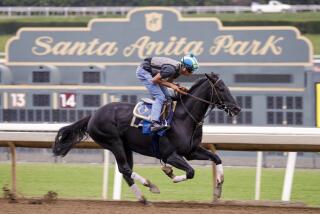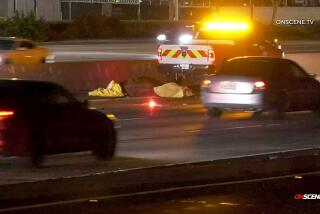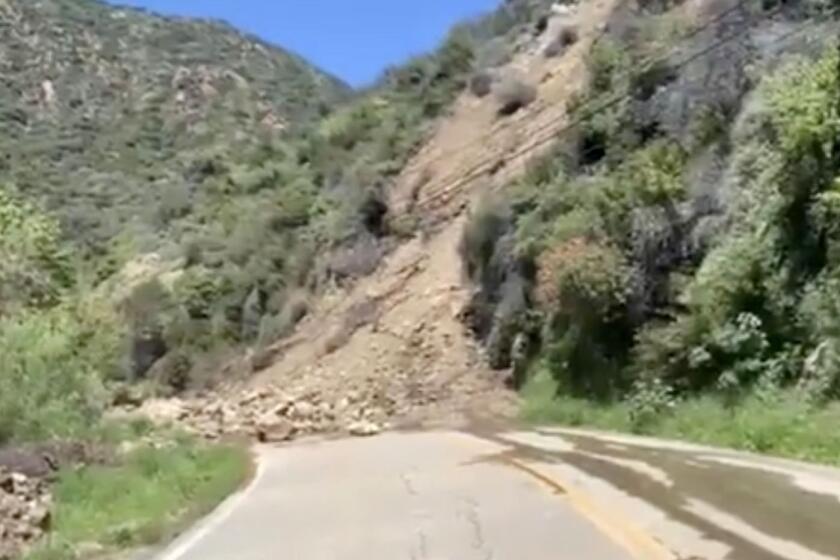Horse owners in the San Fernando Valley feel trod on by bullet train

Dale Gibson grimly shook his head, his white cowboy hat blocking out the bright afternoon sun.
“How about this mess,” he said, walking through his Sunland ranch in the shadow of the San Gabriel Mountains.
Gibson, a rodeo cowboy and stuntman who has performed in more than five dozen films, was pondering the prospect of 220-mph bullet trains rocketing about 100 feet from his competition arena along the Big Tujunga Wash. He boards about 100 horses on 5 acres and, on many days, is out teaching children and actors the finer points of riding.
“It would be like trying to ride your horse down the runway at LAX,” Gibson said. “We will be done.”
Among the myriad complaints about the mammoth $64-billion bullet train project — taxpayers angry over the cost, farmers fuming over land grabs and other complaints — the furor from horse owners has come at bureaucrats out of left field.
Horse owners have unleashed their wrath on bullet train officials in public meetings over the last year in a clash reminiscent of the 19th century collision between the Transcontinental railroad and the horse culture of the Great Plains. The horse owners want the above-ground section of tracks through their communities routed elsewhere, put in tunnels or eliminated altogether.
See more of our top stories on Facebook >>
Fritz Bronner, a veteran Rose Parade horseman who lives in Lake View Terrace with his four horses, said he was outraged over the state’s handling of the issue. “These are not lawn ornaments,” he said. “We get on these animals and do something with them. My horses can still get spooked and bolt.”
The northern San Fernando Valley horse towns — among the nation’s largest and most vibrant urban equestrian communities — worry their character will be destroyed. Ranch owners estimate as many as 10,000 horses are kept in Sunland, Tujunga, Shadow Hills, Lake View Terrace, Kagel Canyon, Agua Dulce and Acton — all of which could be affected to varying degrees by possible bullet train routes.
Rail officials have not denied those concerns, but they have offered no blanket concessions and carefully avoided confronting critics, instead responding with government jargon.
“The proposed high-speed rail alignments under consideration are going through extensive analysis and environmental review, and a draft environmental document is expected to be released in Spring 2017 with final alignment selection expected by the end of 2017,” agency spokeswoman Lisa Marie Alley said in an email.
Horse owners are not encouraged.
“Imagine taking a nice trail ride and this big thing comes soaring through!” said Nicole Chase, owner of the 10-acre Monte Verde Ranch in Sylmar and an L.A. City Council candidate.
The California High-Speed Rail Authority has been fixing other neighborhood problems up and down the state. It agreed to drastically slow down trains in Silicon Valley to keep wealthy suburbanites happy; replaced a planned six-story viaduct in Fresno with a trench; and is studying costly tunnels under the mountains to keep noise from residents in Santa Clarita and San Fernando.
But the state is trying to avoid a budget-busting solution for horse owners, such as a tunnel stretching from Burbank to Palmdale. Its main effort to placate horse owners has been the commissioning of a $15,000 study on whether bullet trains could unnerve horses.
The study was conducted by the Mineta Transportation Institute at Cal State San Jose using a “rigorous, objective method that is fully independent and guided by university principles,” said Karen Philbrick, the institute’s director.
The study has been met with scorn from horse owners.
In addressing noise concerns, for example, the study quoted a handbook on the psychology of animals, which said: “horses are somewhat deaf compared to us.”
The assertion outrages Gibson who, to prove his point, made a kissing
sound to a horse about 50 feet away. The animal raised its head. “Does he look deaf to you?” asked Gibson, who serves on the Los Angeles Equine Advisory Committee.
“Deaf?” he said. “I don’t think so.”
Horse owners say the Mineta study was tainted by conflicts of interest, citing several linkages between the staffs of the rail authority and the institute. The chief executive of the rail authority serves on the Mineta board.
“They are not independent in any way,” Gina Keil Cruz, a Lake View Terrace civil engineer and equestrian, told rail officials at a recent meeting of the San Fernando Valley Assn. of Governments in Van Nuys.
Philbrick rejected those allegations. But rail authority Chairman Dan Richard acknowledged the effort did not go well, adding that it was arranged by his top executive in Southern California. “It was well-intentioned, perhaps not a well-executed effort, to try to get some preliminary information out there,” he said.
Better answers should be forthcoming in an environmental impact report, he said, adding that he would be open to conducting a new study.
Most horse owners have a tale or two about being thrown, bucked, jolted and heaved off their horse when it became spooked or startled.
“Hour for hour, horseback riding is more dangerous than riding a motorcycle,” said Camie Heleski, a behavioral expert at Michigan State University’s horse management program. A recent study found 45% of brain injuries involving adult recreational sports are caused by horseback riding.
The problem seems to be in the horses’ DNA.
“Horses are accused of moving first and thinking second,” said Claudia Sonder, director of the UC Davis Center for Equine Health. “They are the classic flight animal, evolving over time as prey.”
Gibson, who wears a silver belt buckle the size of a rib-eye steak that he won at a recent roping competition, said horses can be trained to handle extreme conditions. He trained his horse Forty’s Dancer to ride through a burning house for a movie.
Still, he said, Forty’s Dancer can be spooked by unexpected noise. “They want to feel secure,” Gibson said. “Then, we throw that high-speed train at them and it hurts their confidence.”
Some horses would certainly become accustomed to bullet trains hurtling past on their turf, but the owners still resent the intrusion of rail into the equestrian lifestyle that they have shaped in their little corner of the San Fernando Valley.
See the most-read stories this hour >>
It is a world apart from the bucolic farms of Kentucky or the gated estates of British royalty. They are middle-class communities, where residents enjoy special zoning to keep horses next to their homes and enjoy a little slice of the Old West. Feed stores have hay piled up high in the middle of residential streets. And horse paths lead from the Tujunga Wash to miles of trails in the San Gabriel Mountains.
On many weekends, traditional Mexican charreada events are held at an equestrian park in the Big Tujunga Wash, celebrating Mexican cowboy culture. Other events include competitions and shows drawing horses from across Southern California.
Two-lane roads lead into mountain enclaves, such as Kagel Canyon, where the unincorporated community is a mix of upscale homes and run-down shacks. Everybody exists on well water, and horses are as common as cats and dogs.
Kelly Decker, an actress and horse owner who has become active in the rail fight, said the state was “intentionally minimizing the importance of the equestrian community.” In her view, the state seems to consider it a small niche in a big state.
Deeper into the mountains, the unincorporated communities of Acton and Agua Dulce, along California 14, would get hit by any of the three routes.
Kathy Zavala, owner of Rainbow Ridge Ranch in Acton, keeps 55 horses and rides into town for errands. “I don’t think I’ll be able to do that anymore,” she said.
The whole community is on edge over the potential effects of the rail system on schools, businesses and homes, but horse owners seem to have taken the problem hardest.
Toni Haigh, a commercial artist who paints horses and owns seven of her own in Acton, said she’d like to see the rail line put in a tunnel through the area, but she is not optimistic it’s a fight the town can win.
“Acton and Agua Dulce have no funds to fight it, so the rail authority is rolling right over us,” she said.
Twitter: @rvartabedian
ALSO
Padres discipline employee after San Diego Gay Men’s Chorus is drowned out singing national anthem
As Obama tours Hiroshima, bombing survivors in Little Tokyo hope for ‘more than words’
20 injured in San Bernardino Mountains rollover crash
More to Read
Start your day right
Sign up for Essential California for news, features and recommendations from the L.A. Times and beyond in your inbox six days a week.
You may occasionally receive promotional content from the Los Angeles Times.







